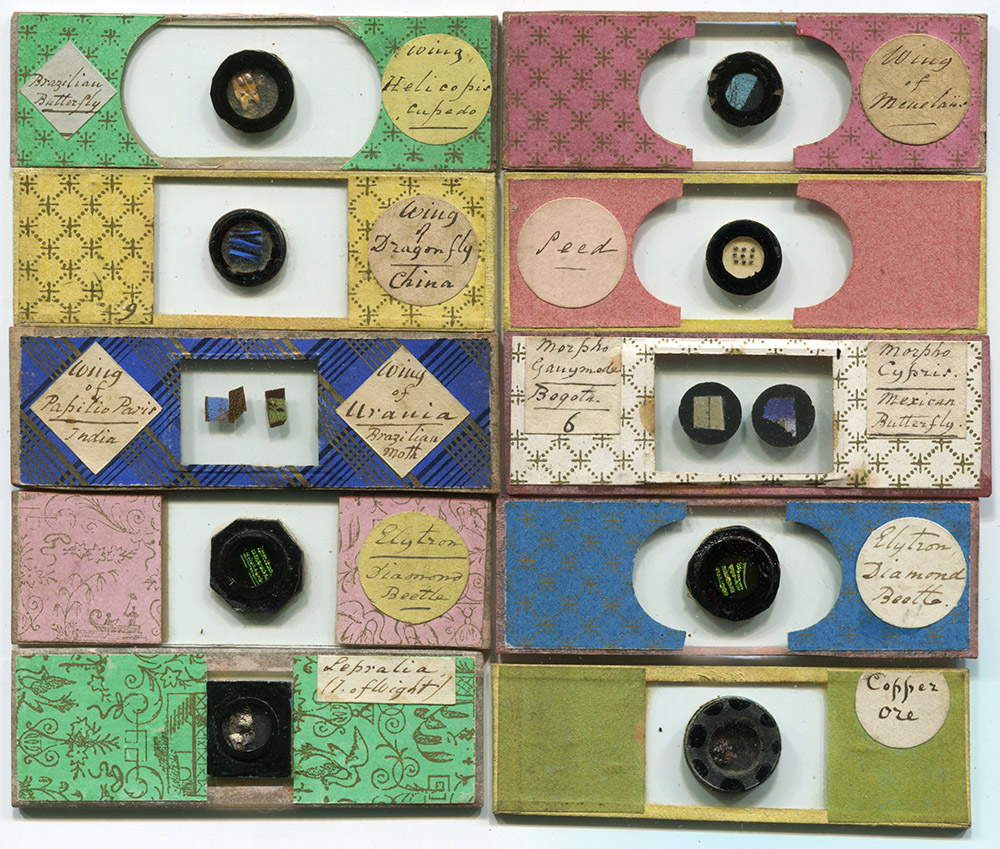
Figure 1. Examples of the half-papered slides produced by this mounter. Duplicates are often seen, leading to suspicion that the maker was a professional slide-maker.
B. West
“Half-Papers”
by Brian Stevenson
last updated December, 2018
This prolific English mounter produced unique, paper-covered microscope slides: the raw glass edges were covered with narrow strips of colored paper, while the front and back often received only partial coverings with paper (Figure 1). This unusual practice led to the slide-maker being nicknamed “Half-Papers” by modern collectors. A wide variety of patterned and plain papers of many colors were used, making for very attractive-looking slides. Half-Papers also produced slides that are entirely covered with papers, yet are recognizable by the maker’s handwritten specimen descriptions. Numerous copies of many different subjects are known, leading to the assumption that Half-Papers was a professional slide-maker. Dated slides imply activity between ca. 1850 and the mid-1870s.

Figure 1.
Examples of the half-papered slides produced by this mounter. Duplicates are often seen, leading to suspicion that the maker was a professional slide-maker.
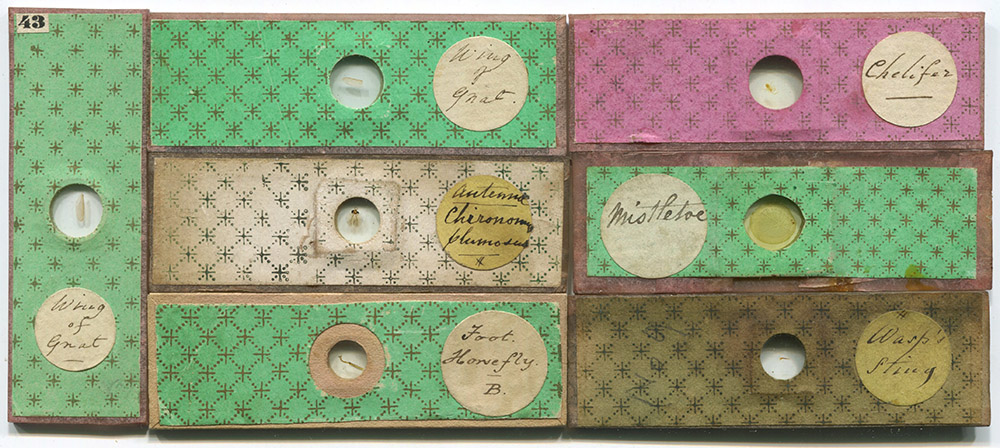
Figure 2.
Examples of slides that are completely covered with papers. Handwriting comparisons indicate that they were made by the same person as the slides shown in Figure 1.
Over the past few years, sharing of information among collectors led to an accumulation of data indicating that Half-Papers’ name was B. West. Evidence is summarized below, and illustrated in the following figures.
![]() John Furze (1817-1859), an early member of the Microscopical Society of London, had a habit of re-labeling slides that he obtained with information such as the maker and the date of acquisition. He noted that a Half-Papers slide of “Spider web viscid lines” was made by “West”, and acquired in 1855 (Figure 3).
John Furze (1817-1859), an early member of the Microscopical Society of London, had a habit of re-labeling slides that he obtained with information such as the maker and the date of acquisition. He noted that a Half-Papers slide of “Spider web viscid lines” was made by “West”, and acquired in 1855 (Figure 3).
![]() Several other of Half-Papers’ slides carry a handwritten “B. West” or “B.W.” (Figure 4).
Several other of Half-Papers’ slides carry a handwritten “B. West” or “B.W.” (Figure 4).
![]() A slide by Joseph Bourgogne (ca. 1805 - ca. 1885) bears a handwritten “B. West” and a secondary label with handwriting that is very similar to Half-Papers’ (Figure 5).
A slide by Joseph Bourgogne (ca. 1805 - ca. 1885) bears a handwritten “B. West” and a secondary label with handwriting that is very similar to Half-Papers’ (Figure 5).
![]() A slide with Smith and Beck covering paper carries a note, “with B.W.’s best regards to Mr. J. Beck” (Figure 6). The handwriting appears to be that of Half-Papers. “J. Beck” is, without a doubt, Joseph Beck (1829-1891). This slide implies that Half-Papers and Joseph Beck knew each other.
A slide with Smith and Beck covering paper carries a note, “with B.W.’s best regards to Mr. J. Beck” (Figure 6). The handwriting appears to be that of Half-Papers. “J. Beck” is, without a doubt, Joseph Beck (1829-1891). This slide implies that Half-Papers and Joseph Beck knew each other.
Who was B. West?
A slide by B. West of “Wing of butterfly, Brazil” carries additional handwriting that appears to be West’s: “Not for Sale - Smith & Beck” (Figure 7). Presumably, this was a sample slide displayed at that microscope shop.
Consistent with the above, numerous B. West slides are known that carry printed labels from Smith, Beck, and Beck (Figure 8). That company routinely printed descriptive labels for slides that they sold. The partnership of Smith, Beck, and Beck lasted from 1857 until 1866. Another possible link between the Becks and West is discussed after Figure 10, below, although that connection may be simply a coincidence.
Another slide suggests that B. West was still actively producing slides into the mid-1870s. The original label on a West slide of “Elytron of (a) Curculio - brilliant” (diamond beetle) also bears the writing “Carpenter p703” (Figure 9). All of the handwriting on this label appears to be that of B. West. “Carpenter” refers to William Carpenter’s The Microscope and its Revelations, which was first published in 1856 and subsequently revised and re-issued throughout the century. Only the 1875, fifth edition of Carpenter described the elytron of Curculio on page 703.
To summarize, Half-Papers was almost certainly B. West, who appears to have been active between the early 1850s and the mid-1870s, at least. West was very likely a professional slide-maker. The Bourgogne slide that is shown in Figure 5 suggests that West had a personal collection of slides. So far, discovery grinds to a halt with those conclusions.
Records have not been identified of a “B. West” being a member of a microscope society such as the Microscopical Society of London / Royal Microscopical Society or the Quekett Microscopical Club. No advertisements or written descriptions of West supplying slides have yet come to light. Several people named B. West lived in London during the mid-1800s, none of whom were obviously involved with microscopes or optics. Even more candidates lived outside of London.
Any information or ideas will be greatly appreciated.
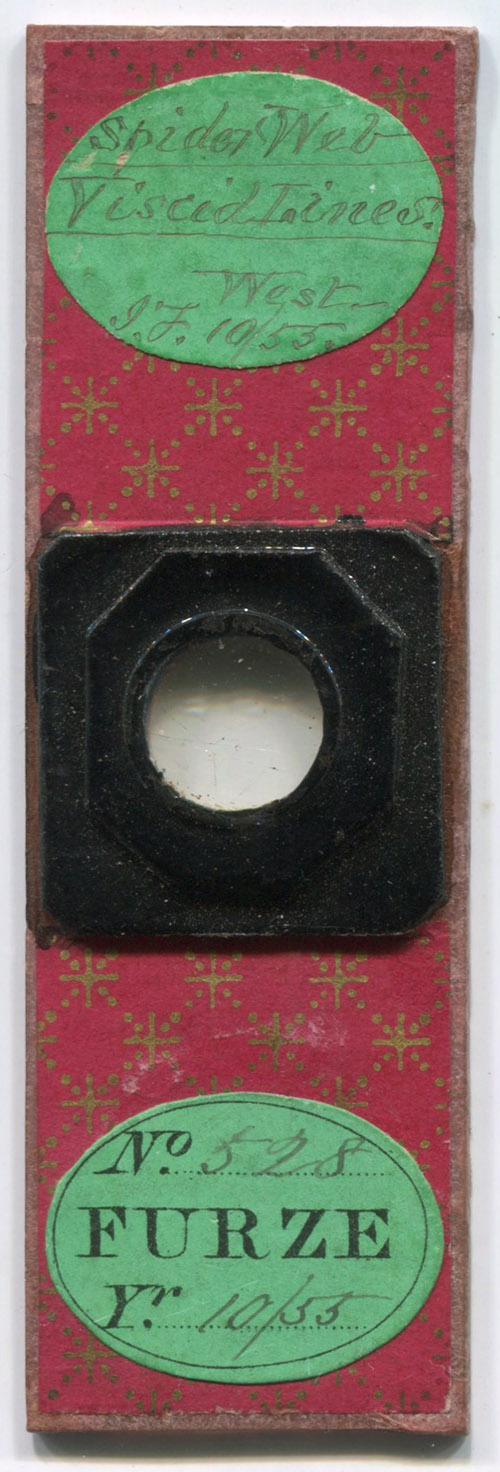
Figure 3.
A slide from the collection of John Furze. The green labels state that he acquired it from a maker named West in 1855. This same slide is shown in Bracegirdle’s “Microscopical Mounts and Mounters” plate 17-Q, although the writing is difficult to read in that image.
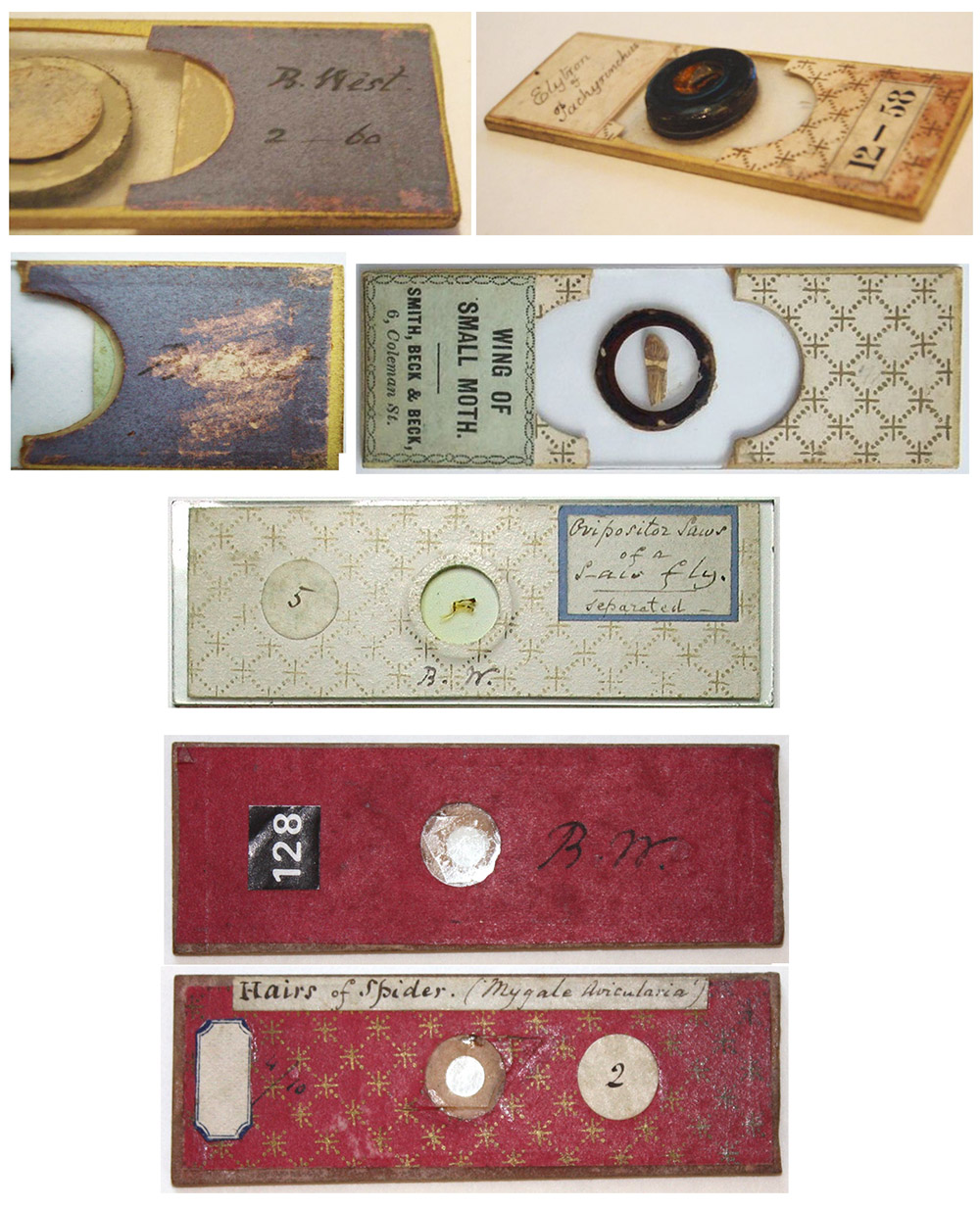
Figure 4.
Slides with “B. West” or “B.W.” in the same handwriting. The top slide is dated February, 1860. Some of the images were adapted for nonprofit, educational purposes from internet auction sites.
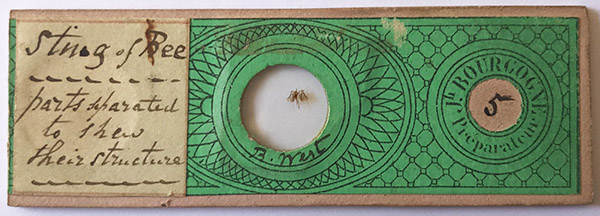
Figure 5.
A slide by Joseph Bourgogne with a handwritten “B. West” and secondary label. The handwriting appears to be the same as that on the slides shown in Figures 1, 2, and 4.
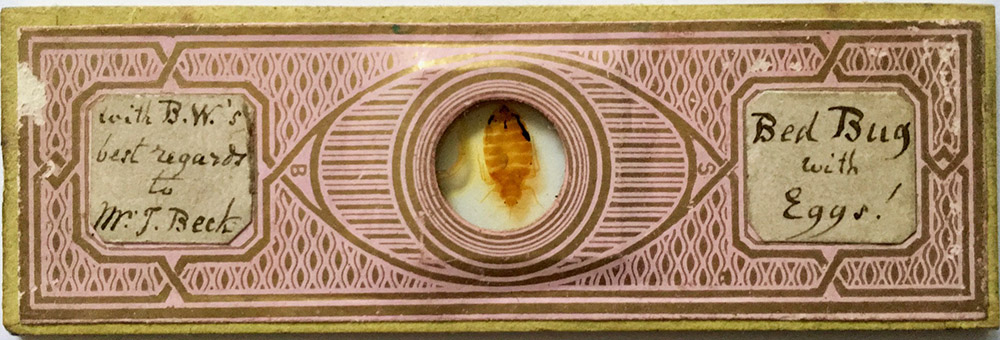
Figure 6.
A slide of “bed bug with eggs”, “with B.W.’s best regards to Mr. J. Beck”. Image courtesy of Trevor Gillingwater.

Figure 7.
Possibly an example slide that was displayed at Smith & Beck? That firm became Smith, Beck and Beck in 1857.
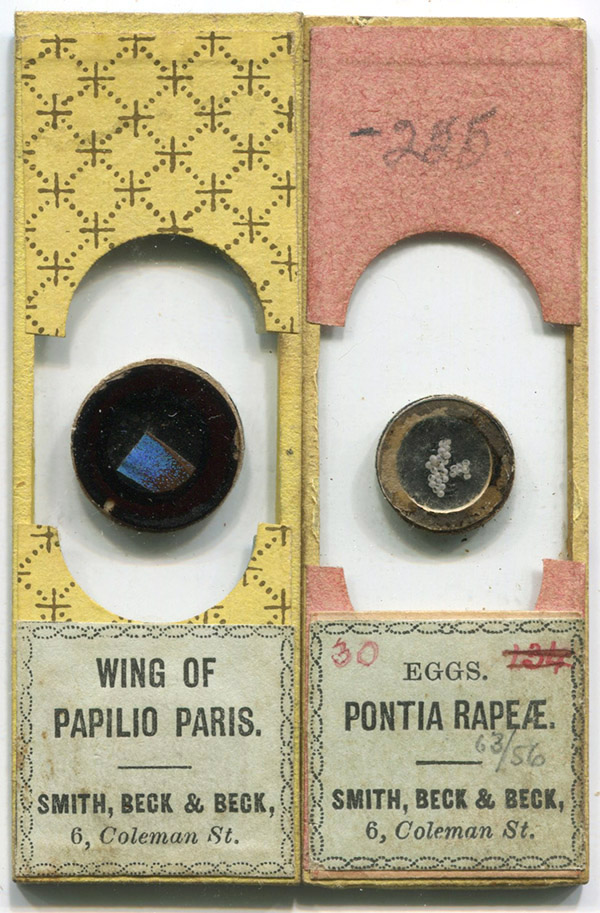
Figure 8.
Examples of slides with Smith, Beck, and Beck retail labels.
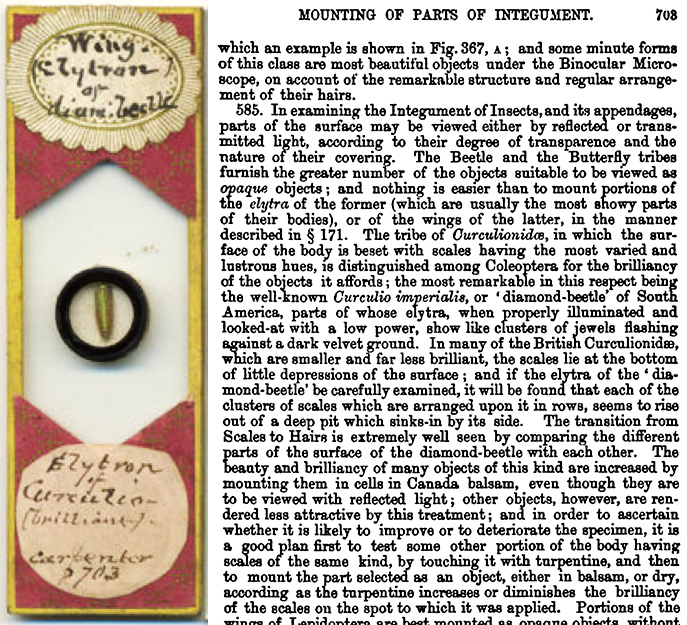
Figure 9.
All of the writing on the lower label appears to be in the same hand. The reference to “Carpenter p703” indicates the 1875 edition of “The Microscope and its Revelations”, the only edition in which Curculio elytra were mentioned on page 703. Slide image adapted for nonprofit, educational purposes from an internet auction site.
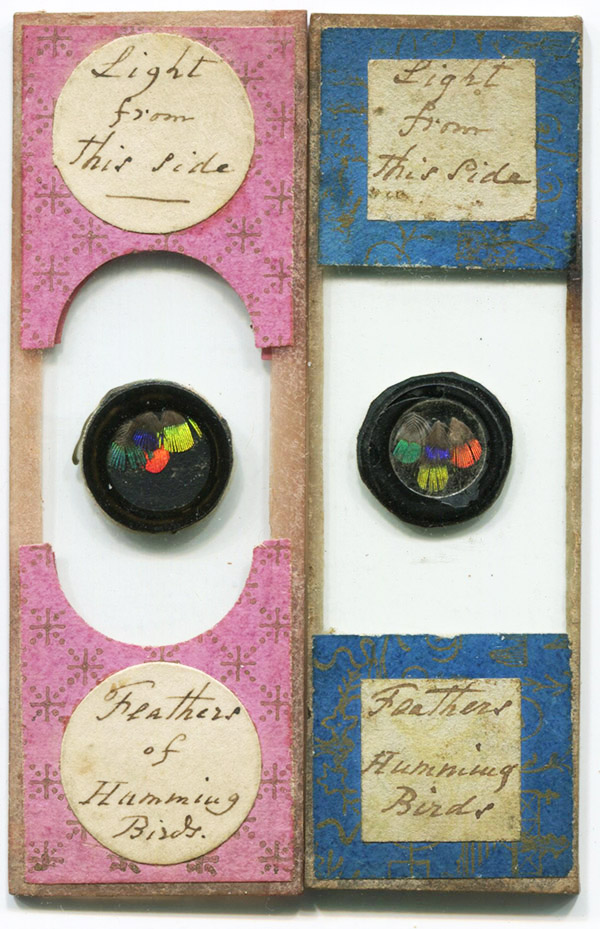
Figure 10.
Attractive specimens in attractive slides: feathers of hummingbirds. Multiple copies of this and other subjects are known, suggesting that the maker was a professional slide-maker.
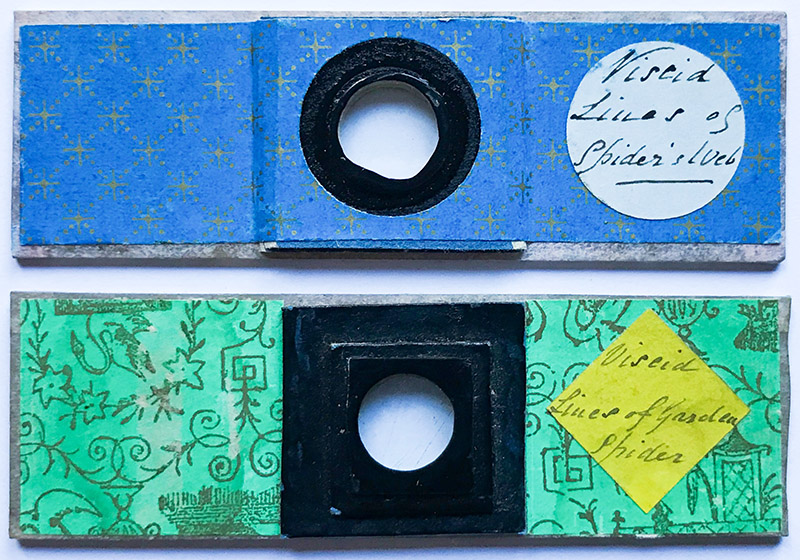
Figure 11.
Additional slides of viscid lines of spider webs.
West prepared a number of slides with “Spider web viscid lines” (e.g. Figures 3 and 11). These are spider web strands with evenly-spaced globules of sticky substance. The means by which the spacing was achieved was a subject of curiosity. Richard Beck presented a description of his studies on viscid lines in 1862, in which he solved the mystery. This was six years after West produced the viscid line slide that is shown in Figure 3, so the topic may not be a direct link between West and R. Beck.
The following was published in The Quarterly Journal of Microscopical Science, 1862:
“As I have, although very casually, alluded in this paper to the large garden spiders, I may, perhaps, be allowed to mention a fact connected with them which came under my notice about the same time.
It is well known that in all the geometric spider webs the concentric lines, with the exception of those in the very centre, are most beautifully dotted with a viscid substance, to aid in the capture of insects. Mr. Blackwall has, I believe, computed that there are more than 100,000 of these gummy drops in a web which is made in about half an hour; it has always, therefore, been a puzzle in my own mind how this part of the process was effected, and as I had been unable to find any one who could give me a satisfactory explanation, I thought I would carefully watch a spider during the operation, when, with only a pocket lens, I could distinctly see that the viscid lines, as first drawn from the abdomen were not dotted.
On a careful examination with a microscope, which I took into the garden, the thread at first appeared only slightly thicker than an ungummed line, but after a very short time undulations appeared, and subsequently, at the most regular distances, the viscid matter formed into alternating large and small globules.
The whole process is such a beautiful illustration of molecular attraction, which Mr. Rainey has been so patiently and profoundly working out with regard to the highest organic structures, that I thought this simple example might interest some of our members. The cold weather has, of course, driven away these spiders till next autumn, at least, but the same result can easily be obtained artificially”.
(Notes: “Mr. Blackwall” was John Blackwall, author of The Spiders of Great Britain, published in 1861. “Mr. Rainey” was George Rainey, author of On the Mode of Formation of Shells of Animals: Of Bone, and of Several Other Structure, by a Process of Molecular Coalescence, Demonstrable in Certain Artificially Formed Products, published in 1858.)
Acknowledgements
Thank you to Howard Lynk, Peter Hodds, and Trevor Gillingwater for generously sharing ideas and images, and for helpful comments on this essay.
Resources
Beck, Richard (1862) On the viscid lines in a spider’s web, Quarterly Journal of Microscopical Science, pages 17-18
Blackwall, John (1861) The Spiders of Great Britain, The Ray Society, London
Bracegirdle, Brian (1998) Microscopical Mounts and Mounters, Quekett Microscopical Club, London, Plate 17-Q
Rainey, George (1858) On the Mode of Formation of Shells of Animals: Of Bone, and of Several Other Structure, by a Process of Molecular Coalescence, Demonstrable in Certain Artificially Formed Products, John Churchill, London